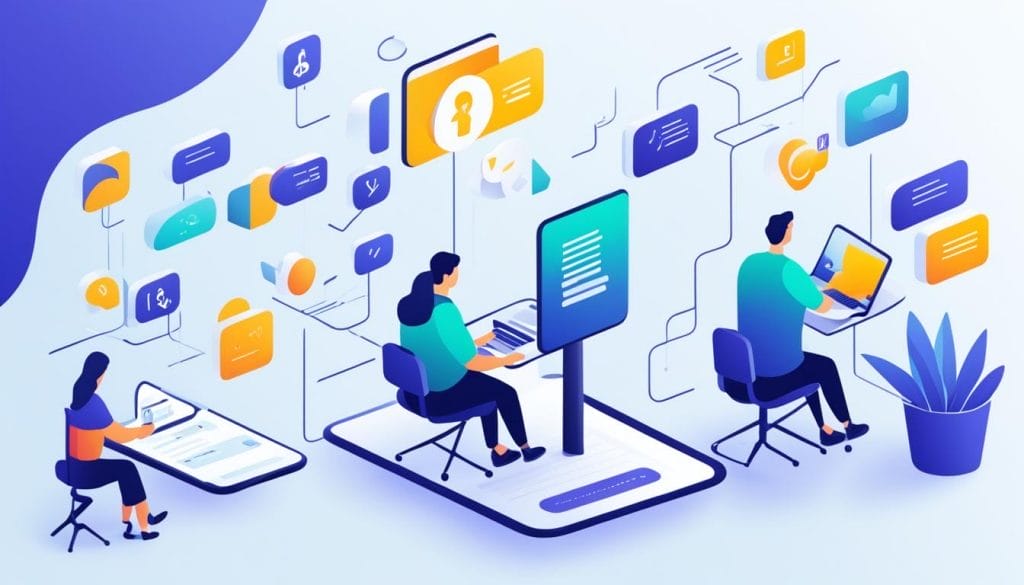https://www.youtube.com/watch?v=HtASocaRO-M
Did you know that instructional design pros spend about 30% of their time on boring tasks? That’s a lot of time that could be used for more creative work. Luckily, artificial intelligence (AI) is changing the game in instructional design. It helps improve workflow and make things more efficient.
AI lets instructional design teams automate boring tasks and make processes smoother. This means they can create better learning experiences faster. With AI, the possibilities for making things more efficient are endless. From making learning paths more personal to using AI in games and simulations, the options are vast.
This article will show how AI can change instructional design. We’ll look at how AI can automate making curriculums, improve making content, and check its quality. Get ready to see how AI tools and methods can change your work and make your instructional design better.
Key Takeaways:
- AI-powered instructional design enables automation of repetitive administrative tasks.
- Personalized learning paths enhance engagement and improve learning outcomes.
- AI-driven games and simulations captivate learners and enhance the learning experience.
- AI tools streamline workflow and collaboration in instructional design projects.
- AI-powered evaluation ensures the effectiveness of instructional design strategies.
The Power of Personalized Learning Paths
Not every student learns the same way. That’s why personalized learning paths with AI are so powerful. They make learning fit each student’s unique needs and likes.
AI-driven adaptive learning systems look at lots of data to make learning personal. They see what each student knows and what they don’t. Then, they change the lessons to fit each student’s learning style.
This makes learning more engaging and effective. Students do better when the material is made just for them. They stay interested and remember more.
AI helps make designing lessons more efficient. Designers don’t have to make the same lesson for everyone. They can make lessons that meet each student’s goals.
Personalized learning helps students outside the classroom too. As students move forward, AI keeps making the learning better and more tailored to them.
With AI, teachers focus on what each student needs. AI spots areas where students need more help and suggests extra resources. It also gives personalized tests. This way, students can learn better and reach their highest potential.
Enhancing Engagement with AI-Driven Games and Simulations

AI-powered games and simulations have changed education, making learning fun and interactive. They blend game-based learning and simulations into lessons. This approach boosts learner engagement and helps them understand better.
Games tap into learners’ love for play and competition. They turn learning into fun, interactive experiences. This grabs learners’ attention and keeps them motivated to learn. AI helps by adjusting the game to fit each learner’s level, offering challenges that are just right.
Interactive simulations let learners solve problems in real-life scenarios. These scenarios are linked to their learning goals. By diving into these simulations, learners can use what they’ve learned, make decisions, and see the effects. This builds critical thinking and problem-solving skills.
These AI-driven tools don’t just make learning more fun; they also help learners remember and use what they’ve learned. Interactive learning is more effective than just listening or reading. Games add elements like rewards and feedback, making learning exciting and encouraging learners to keep going.
Games and simulations are not just great for keeping learners engaged; they also offer insights into how learners are doing. By looking at how learners interact and perform, teachers can make better lesson plans and help learners improve.
The Benefits of Enhanced Engagement
Games and simulations bring many benefits:
- They make learning more fun and motivating, leading to better participation.
- They help learners remember more and keep the information in their long-term memory.
- They develop critical thinking and problem-solving skills through practical application.
- They offer immediate feedback, helping learners see what they’re good at and what they need to work on.
- They encourage teamwork and social interaction, as many games support playing with others.
Using AI-driven games and simulations in teaching opens up new ways to engage learners and meet learning goals. These tools create lively learning spaces that capture learners’ interest and push them to do their best.
Streamlining Workflow in Instructional Design with AI Tools
AI tools have changed how we work in instructional design. They make the process more efficient and improve how we create content. These tools help at every step, from starting a project to checking the final product.
AI can do tasks like transcribing interviews and summarizing articles automatically. It also helps with finding relevant content, planning the course, and grading work. This lets designers spend more time on tasks that need a human touch.
AI helps designers manage and analyze lots of data. This makes it easier to find important insights and trends. It also makes working together in teams smoother and ensures the quality of the design work.
AI can spot where learners need more help and customize their learning. It looks at how learners do and suggests the best content or paths for them. This makes learning more engaging and personal.
AI doesn’t replace designers but gives them new tools and insights. By using AI, designers can work more efficiently and make learning better for everyone.
Improving Instructional Design through AI-Driven Curriculum Development

AI analysis is changing how we make curriculums. It helps educators understand what learners need and want. This makes learning more effective.
Creating curriculums means making plans that meet different learner needs. Before, this was done mostly by hand, which sometimes missed the mark. Now, AI helps make learning paths that fill in gaps and keep learners interested.
AI helps educators make smart choices with lots of data. It spots patterns to understand how learners behave and what they keep in their minds. This way, content can be made just for each learner, making learning better for everyone.
AI is great at finding where learners are struggling. It helps teachers focus on these areas to make sure learners get the help they need. This means learners can do better in their studies.
Also, AI keeps up with new trends in education. It helps teachers know the latest in teaching methods. This means curriculums stay fresh and prepare learners for the future.
In short, AI makes learning more personal and engaging. It turns making curriculums into a process based on data. This gives insights into what learners need and helps make learning relevant in a changing world.
AI-Powered Content Creation for Enhanced Efficiency
In the world of teaching, using AI to make content can make things faster and better. These tools help write content that is interesting and of high quality. They save time for those who design lessons.
AI can help with many tasks, like making first drafts of lesson plans and finding content online. It uses smart algorithms to understand what students need to learn. This lets designers focus on making the content better, not just starting over.
AI is great at helping with videos and audio too. It can turn audio into text and captions, reaching more people. It also gives feedback to make sure the content works well.
AI changes teaching by adding fun parts to lessons. Things like quizzes and games make learning more engaging. This gets students more involved.
AI is also key for making sure everyone can access learning. It can make captions, transcriptions, and translations. This helps meet the needs of all learners.
Using AI in making content makes things better and more effective. It automates boring tasks and gives smart advice. This lets designers create new and interesting lessons that really speak to their students.
| Benefits of AI-Powered Content Creation: |
|---|
| 1. Time-saving generation of initial curriculum drafts |
| 2. Efficient curation of content from online sources |
| 3. Seamless integration with video and audio editing |
| 4. Addition of interactive elements for enhanced engagement |
| 5. Compliance with accessibility laws through generated captions, transcriptions, and translations |
The future of teaching is linked with AI. By using these tools, designers can do more, work better, and engage students more. This will change education and help future generations.
Ensuring Accessibility and Compliance with AI in Instructional Design

When designing instruction, making sure it’s accessible and follows the law is key. AI tools are now big helps in this area. They offer many features that make learning available to everyone and follow legal rules.
AI tools make learning better by making captions, transcribing audio, and translating languages. These tools help learners who have hearing or language issues to fully understand the material.
AI also helps with following the law by looking at laws like the Rehabilitation Act of 1973 and the Web Content Accessibility Guidelines (WCAG). It checks design parts and suggests changes to make sure the content meets these standards.
Another important thing is giving learners different formats. AI tools can change materials into Braille or large print for people who can’t see well. This makes learning more inclusive.
AI algorithms help designers by looking at how learners interact with the material. This helps find and fix any barriers to learning. By using AI, designers can make courses better for everyone over time.
By using AI in designing instruction, designers can focus on making it accessible and following the law from the start. These tools help find and fix any issues, making sure all learners can use the material.
The Role of Instructional Designers and AI Tools in Compliance
AI tools are a big help in making learning accessible and following the law, but they don’t replace designers. They work together to make the design process smoother.
Designers are key in making sure learning is accessible and follows the law. They work with experts and use AI to check and improve course materials. This makes sure they’re good for everyone.
With AI’s help, designers can focus on making learning better, using good teaching methods, and creating fun learning experiences. AI takes care of making sure the learning is accessible and follows the law.
As instructional design changes, using AI tools will be more important for meeting learning needs and following laws. By using AI, designers can make learning places that everyone can get into.
| Benefits of AI in Ensuring Accessibility and Compliance | |
|---|---|
| Automated creation of captions for multimedia content | ✔ |
| Transcription of audio materials | ✔ |
| Language translation functionality | ✔ |
| Evaluation of design elements for adherence to accessibility laws | ✔ |
| Conversion of instructional materials into alternative formats | ✔ |
| Data analysis for identifying barriers to accessibility | ✔ |
AI Tools for Project Management and Collaboration in Instructional Design
Managing and collaborating on instructional design projects is key to success. AI tools are changing how designers work. They make tasks more efficient, improve communication, and help meet project goals.
AI tools help plan and organize projects. They track progress and update everyone in real-time. This means designers can focus on the big picture and deliver projects on time.
Working together is important in design projects. AI tools make it easier for teams to communicate and work together. Designers, experts, and stakeholders can collaborate smoothly, no matter where they are. These tools offer features like live document editing and messaging to keep everyone in sync.
For instance, designers can share documents and get feedback instantly with AI tools. This makes reviews faster and keeps all comments in one place.
Using AI for project management and collaboration helps designers:
- Maximize Efficiency: AI does repetitive tasks, giving designers more time for important work.
- Improve Communication: AI tools make it easy for teams to talk and work together well.
- Ensure Timely Delivery: AI tracks progress and updates everyone, keeping projects on track.
- Enhance Stakeholder Collaboration: AI helps involve stakeholders and make sure their needs are met.
- Manage Version Control: AI keeps track of changes and ensures everyone has the latest info.
AI tools make design teams work better together, communicate smoothly, and deliver top-notch learning experiences. They help designers collaborate, meet deadlines, and create impactful content.
To learn more about using AI in design work, check out these resources:
- Visit the University of Cincinnati’s blog to see how AI is changing design work.
- Read this article from EDUCAUSE to learn about AI’s impact on design.
- For a detailed guide on using AI in training, see this article from eLearning Industry.
AI-Powered Evaluation of Instructional Design Effectiveness
Assessing the effectiveness of instructional design is key. AI tools help by offering insights into how well materials work. They show what needs work and how to make things better.
AI looks at learner feedback right away. It spots patterns and challenges learners face. This info helps designers know what to fix, making courses better and more effective.
AI tools give feedback in real-time, showing what learners struggle with. Designers can then quickly change their materials. This makes learning better for everyone.
AI doesn’t just point out what’s wrong. It helps make learning better by checking how well materials work. This leads to more efficient learning, more engagement, and better retention of knowledge.
AI gives designers insights and helps them make smart choices. By using AI, educators can work smarter and get better results in their designs.
AI evaluation keeps getting better with each update. By looking at feedback and tweaking materials, educators can make their designs even better over time.
Want to make your instructional design better? Use AI for evaluation and feedback. AI insights help you create learning experiences that really engage your learners.
Real-time Insights for Continuous Improvement
AI gives designers real-time feedback from learners. This lets them spot problems, check how well materials work, and make changes as needed.
Optimizing Instructional Design Efficiency
Using AI for evaluation and feedback makes designing more efficient. Designers can make better decisions with data. This leads to better use of time and resources, making their work more impactful.
Staying Up-to-Date with AI in Instructional Design Trends
AI tools are key for keeping instructional designers ahead in the field. They help designers stay informed, flexible, and creative with their strategies.
Curating and Analyzing Industry Sources
AI tools help designers sort through lots of industry sources like research papers and journals. They find the most important trends and insights for design.
AI tools analyze data quickly and efficiently. This gives designers a clear view of what’s new without getting lost in too much information.
Identifying Emerging Trends
AI tools use advanced algorithms to spot new trends in design. They watch for changes in what learners want and new tech and teaching methods.
This helps designers get ready for changes in learning. By being proactive, they can make learning experiences that meet learners’ new needs.
Recommendations for Adjusting Strategies
AI tools analyze trends and give advice on how to improve design strategies. They suggest changes and new ways to teach based on what they find.
With AI’s help, designers can make sure their methods are up-to-date. This leads to more engaging and effective learning experiences.
Using AI keeps designers current with the latest in design trends. AI helps by finding new sources, spotting trends, and offering advice. This way, designers can always get better at what they do and make a big impact on learning.
| Benefits of Staying Up-to-Date with AI in Instructional Design Trends | Achieved through AI Tools |
|---|---|
| Access to the latest research | Curating and analyzing industry sources |
| Anticipating changes in learner preferences | Identifying emerging trends |
| Optimizing instructional design strategies | Recommendations for adjusting strategies |
Conclusion – Leveraging Hyperspace for AI-Powered Instructional Design
Hyperspace is the top choice for using AI in making courses. It lets you create engaging, interactive lessons without needing to code. With AI, learning becomes more immersive and fun.
This platform uses 3D environments, VR/AR, and games to keep learners hooked. It also tracks progress to show how well the training works. Hyperspace makes learning better, more efficient, and changes the way we use AI in education.
FAQ
How does AI optimize instructional design workflow?
AI makes instructional design more efficient by automating tasks. It helps streamline the workflow and improve learning experiences. AI tools create content, set timelines, track progress, and help with project management and teamwork.
How does AI create personalized learning paths?
AI looks at learner data like past performance and likes to make lesson plans just for them. It uses adaptive learning to give feedback and change lessons on the fly. This makes learning more effective.
How does AI enhance learner engagement?
AI makes learning fun with customized games and simulations based on how well learners do. These interactive experiences offer challenges that change and keep learners engaged. This helps them remember more and understand better.
How do AI tools streamline instructional design workflow?
AI tools help at every step of making instructional materials. They transcribe interviews, summarize articles, and create content plans. They also suggest how to organize courses and grade work automatically.
How does AI improve curriculum development?
AI uses smart analysis to find out what learners need and spot gaps in learning. It suggests changes to keep up with new trends in education. AI helps set goals and tailor the curriculum to learners’ needs.
How does AI aid in content creation?
AI can start making curriculum drafts and pick content from the web. It helps with editing videos and adding fun elements to make content better. AI also makes sure content follows accessibility laws.
How does AI ensure accessibility and compliance in instructional design?
AI automatically adds captions, transcribes audio, and translates languages. It checks if materials follow accessibility laws. AI uses data analysis to make courses more accessible and follow the law.
How do AI tools assist in project management and collaboration in instructional design?
AI tools make managing projects easier by setting timelines and tracking progress. They help get everyone involved and keep versions in check. This leads to smooth projects, on-time delivery, and good team communication.
How does AI evaluate the effectiveness of instructional design materials?
AI looks at what learners say to find ways to get better. It gives real-time tips to designers and helps improve courses. AI-driven checks keep making instructional design better and more effective.
How can instructional designers stay up-to-date with AI trends?
AI tools keep track of industry news and trends, helping designers stay current. This lets designers use AI to meet new learning needs and offer fresh solutions.
How can Hyperspace revolutionize instructional design with AI?
Hyperspace is the top choice for using AI in making training. It lets designers create immersive, interactive training without coding. It uses AI to make learning more engaging and shows clear results.




